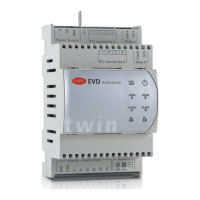ENG
“EVD Evolution TWIN” +0300006EN - rel. 2.6 - 31.01.2019
29
6. FUNCTIONS
6.1 Power supply mode
EVD evolution twin can be powered at 24 Vac or 24 Vdc. In the event of direct
current power supply, after completing the commissioning procedure, to
start control set “Power supply mode” parameter=1.
Parameter/Description Def. Min. Max. UOM
SPECIAL
Power supply mode
0=24 Vac
1= 24 Vdc
0 01-
Tab. 6.a
Important: with direct current power supply, in the event of power
failures emergency closing of the valve is not performed, even if the
EVD0000UC0 module is connected.
6.2 Battery charge delay
Battery charge delay to allow battery charging. In the presence of a battery to
close the valve, to avoid missing emergency closing in case of repeated and
close blackouts, a regulation start delay has been introduced, congurable by
the user depending on the backup system used (ultracap or lead battery). This
delay, if set to a value> 0, occurs every time the driver is turned on to allow
the battery to recharge.
Parameter/description Def.
ADVANCED
Battery charge delay 0 min
6.3 Network connection
Important: to set the pLAN address, follow the guidelines in chap.4.
To connect an RS485/Modbus® controller to the network, as well as the
network address parameter (see paragraph 4.2), using the “Network settings”
parameter.
Parameter Description Def.
SPECIAL
Set conguration parity Bit stop Baud rate
0 none parity 2 bit stop 4800 bps
1 none parity 2 bit stop 9600 bps
2 none parity 2 bit stop 19200 bps x
4 none parity 1 bit stop 4800 bps
5 none parity 1 bit stop 9600 bps
6 none parity 1 bit stop 19200 bps
16 even parity 2 bit stop 4800 bps
17 even parity 2 bit stop 9600 bps
18 even parity 2 bit stop 19200 bps
20 even parity 1 bit stop 4800 bps
21 even parity 1 bit stop 9600 bps
22 even parity 1 bit stop 19200 bps
24 odd parity 2 bit stop 4800 bps
25 odd parity 2 bit stop 9600 bps
26 odd parity 2 bit stop 19200 bps
28 odd parity 1 bit stop 4800 bps
29 odd parity 1 bit stop 9600 bps
30 odd parity 1 bit stop 19200 bps
Tab. 6.b
Note: To use the Carel protocol you must use the default settings:
• byte size: 8 bits;
• stop bits: 2;
• parity: none.
6.4 Inputs and outputs
Analogue inputs
The parameters in question concern the choice of the type of pressure/liquid
probe S1 and S3 and the choice of the temperature probe S2 and S4, as
well as the possibility to calibrate the pressure and temperature signals. As
regards the choice of pressure/liquid probe S1 and S3, see the chapter on
“Commissioning”.
Inputs S2, S4
The options are standard NTC probes, high temperature NTC, combined
temperature and pressure probes and 0 to 10 Vdc input. For S4 the 0 to 10
Vdc input is not available. When choosing the type of probe, the minimum
and maximum alarm values are automatically set. See the chapter on “Alarms”.
Type CAREL code Range
CAREL NTC (10K at 25°C) NTC0**HP00 -50T105°C
NTC0**WF00
NTC0**HF00
CAREL NTC-HT HT (50K at 25°C) NTC0**HT00 0T120°C
(150 °C for 3000 h)
Combined NTC SPKP**T0 -40T120°C
NTC low temperature NTC*LT* -80T60°C
Important: for combined NTC probes, also select the parameter
relating to the corresponding ratiometric pressure probe.
Parameter/description Def.
CONFIGURATION
Probe S2:
1= CAREL NTC; 2= CAREL NTC-HT high T.; 3= Combined NTC
SPKP**T0; 4= 0 to 10 V external signal; 5=NTC – LT CAREL low
temperature
CAREL NTC
Probe S4:
1= CAREL NTC; 2= CAREL NTC-HT high T.; 3= Combined NTC
SPKP**T0; 4 = ---; 5=NTC – LT CAREL low temperature
CAREL NTC
Tab. 6.c
Calibrating pressure probes S1, S3 and temperature
probes S2 and S4 (oset and gain parameters)
If needing to be calibrate:
• the pressure probe, S1 and/or S3, the oset parameter can be used, which
represents a constant that is added to the signal across the entire range of
measurement, and can be expressed in barg/psig. If the 4 to 20 mA signal
coming from an external controller on input S1 and/or S3needs to be
calibrated, both the oset and the gain parameters can be used, the latter
which modies the gradient of the line in the eld from 4 to 20 mA.
• the temperature probe, S2 and/or S4, the oset parameter can be used,
which represents a constant that is added to the signal across the entire
range of measurement, and can be expressed in °C/°F. If the 0 to 10
Vdc signal coming from an external controller on input S2 needs to be
calibrated, both the oset and the gain parameters can be used, the latter
which modies the gradient of the line in the eld from 0 to 10 Vdc.
420
A
B
mA
010
A
B
Vdc
Fig. 6.a
Key:
A= oset, B= gain
Parameter/description Def. Min. Max. UOM
Probes
S1: calibration oset 0 -60 (-870),
-60
60 (870),
60
barg (psig),
mA
S1: calibration gain, 4 to 20 mA 1 -20 20 -
S2: calibration oset 0 -20 (-36) 20 (36) °C (°F), volt
S2: calibration gain, 0 to 10 V 1 -20 20 -
S3: calibration oset 0 -60 (-870) 60 (870) barg (psig)
S3: calibration gain, 4 to 20 mA 1 -20 20 -
S4: calibration oset 0 -20 (-36) 20 (36) °C (°F)
Tab. 6.d

